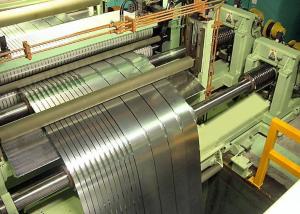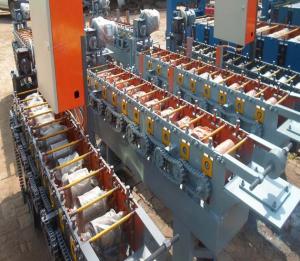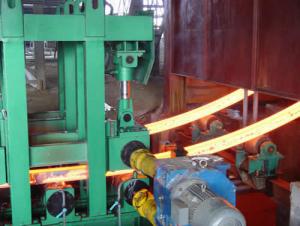Continuous Casting Machine for Steel
- Loading Port:
- China Main Port
- Payment Terms:
- TT or LC
- Min Order Qty:
- 1 Set set
- Supply Capability:
- 30 Sets Per Year set/month
OKorder Service Pledge
Quality Product, Order Online Tracking, Timely Delivery
OKorder Financial Service
Credit Rating, Credit Services, Credit Purchasing
You Might Also Like
Technology process:
1.Heat the EVA film
2.Cover the heated EVA film on the mould(can be made from wood or aluminum)
3.Spray a coating in a certain baume degree
4.Put on the empty blask
5.Sand-up the flask and vibrate to compaction
Packaging & Delivery
Packaging Details:containers
Delivery Detail:a set complete equipment needed producting three months
- Q: Can metal casting machinery be used for investment casting of shape memory alloys?
- Yes, metal casting machinery can be used for investment casting of shape memory alloys. Investment casting, also known as lost-wax casting, is a widely used method for producing complex metal parts with high dimensional accuracy. It involves creating a wax pattern that is coated with a ceramic shell, which is then heated to melt and remove the wax, leaving behind a cavity. Molten metal is then poured into the cavity and allowed to solidify before the ceramic shell is broken away to reveal the final part. Shape memory alloys, such as Nitinol, are a type of metallic material that exhibit unique properties, including the ability to return to their original shape after being deformed. These alloys are often used in various industries, such as aerospace, medical, and automotive, due to their shape memory and superelasticity characteristics. Metal casting machinery can certainly be used for investment casting of shape memory alloys. The process of investment casting allows for the production of intricate shapes and complex geometries, making it suitable for shape memory alloy parts that require high precision and intricate features. The machinery used for investment casting can handle the melting and pouring of shape memory alloys, ensuring that the molten metal is properly cast into the ceramic shell and solidifies to form the desired shape. However, it is important to note that the casting parameters may need to be adjusted to accommodate the specific characteristics of shape memory alloys. These alloys have unique thermal and mechanical properties, which can affect the casting process. It may be necessary to control the cooling rate, preheat the mold, or use specific pouring techniques to ensure proper solidification and retain the desired shape memory properties of the alloy. In conclusion, metal casting machinery can be effectively used for investment casting of shape memory alloys. This process allows for the production of complex and precise parts, making it suitable for the manufacturing of shape memory alloy components in various industries. However, careful consideration and potential adjustments to the casting parameters may be required to account for the unique properties of shape memory alloys.
- Q: How does metal casting machinery handle the removal of metal from molds?
- Metal casting machinery uses various methods to handle the removal of metal from molds. One common technique is known as shakeout, where the mold is vibrated or shaken to release the cast metal. This process helps separate the metal from the mold material, such as sand or ceramic, which is then discarded or recycled. Another method is knockout, which involves using mechanical force to remove the cast metal from the mold. This can be done manually or with the help of pneumatic or hydraulic systems that exert pressure to dislodge the metal. Additionally, some metal casting machinery employs the use of mold release agents to facilitate the removal process. These agents are applied to the mold surface before casting, forming a thin film that reduces the adhesion between the metal and the mold. As a result, the metal can be easily removed from the mold without causing any damage. Furthermore, in certain advanced metal casting techniques like investment casting, the molds are made of a material that can be easily broken or dissolved. Once the metal has solidified, the mold is shattered or dissolved, allowing the metal casting to be easily retrieved. Overall, metal casting machinery utilizes a combination of mechanical force, vibration, mold release agents, and specialized mold materials to handle the removal of metal from molds efficiently and safely.
- Q: How does metal casting machinery handle the removal of excess material and finishing of the final product?
- Metal casting machinery handles the removal of excess material and finishing of the final product through various processes. Typically, after the casting is solidified, the excess material, known as the casting sprue, is removed using cutting or grinding tools. The final product is then refined and polished using techniques such as sanding, grinding, or buffing. Additionally, specialized machines may be used for specific finishing tasks like shot blasting or tumbling to achieve the desired surface smoothness and appearance.
- Q: What are the noise and vibration levels of metal casting machinery?
- The noise and vibration levels of metal casting machinery can vary depending on various factors such as the type of machinery, its size, design, and operating conditions. However, metal casting machinery generally produces high levels of noise and vibrations due to the mechanical processes involved, such as the movement of molds, pouring of molten metal, and cooling processes. To mitigate these levels, manufacturers often implement noise reduction measures and vibration dampening techniques to ensure worker safety and minimize environmental impact.
- Q: How are molds made in metal casting machinery?
- Molds are made in metal casting machinery through a process called pattern making. A pattern, which is a replica of the desired metal part, is created using materials such as wood, plastic, or metal. This pattern is then placed in a flask, and a molding material, typically sand, is packed around it to form a mold cavity. The pattern is removed, leaving a hollow space in the shape of the desired part. Molten metal is then poured into the mold cavity, where it solidifies and takes the shape of the pattern. Once the metal has cooled and hardened, the mold is opened, and the metal casting is removed, ready for further processing or use.
- Q: How are the gates and runners designed in metal casting machinery?
- The flow of molten metal into the mold cavity in metal casting machinery relies heavily on the gates and runners. These components are essential for the success of the casting process as they enable proper filling, solidification, and subsequent removal of the casting. When designing the gates and runners, several factors need to be taken into account. Firstly, the geometry of the mold and the desired shape and size of the casting are considered. The goal is to design a gating system that promotes smooth and controlled metal flow, minimizing turbulence and the occurrence of defects like air entrapment or porosity. The design process also takes into consideration the properties of the metal being cast, including its viscosity, temperature, and solidification characteristics. These factors influence the selection of gate and runner dimensions, as well as their shape and orientation. For instance, metals with high viscosity require larger gates and runners to accommodate the flow rate, while metals with low solidification temperature may require shorter runners to prevent premature solidification. Furthermore, the design of gates and runners is influenced by the specific type of casting being produced. Different casting methods like sand casting, investment casting, or die casting may necessitate specific gating systems. For example, in sand casting, where the mold is made of sand, the design focuses on minimizing turbulence and ensuring proper sand compaction to prevent mold erosion. In addition, the design of the gating system considers factors such as the location of the sprue, which is the main channel through which the molten metal enters the mold, and the placement and number of gates, which distribute the metal to different sections of the mold cavity. These elements are strategically positioned to promote uniform filling and reduce the occurrence of defects like cold shuts or misruns. Overall, the design of gates and runners in metal casting machinery is a complex process that combines engineering principles, material properties, and knowledge of the casting method. By carefully considering these factors, engineers can optimize the gating system to ensure successful and high-quality castings.
- Q: How is the excess material trimmed and finished using metal casting machinery?
- The excess material is trimmed and finished using metal casting machinery through a process known as machining. Machining involves the use of cutting tools and techniques to remove the unwanted material and achieve the desired shape and surface finish of the final product. This can include operations such as milling, turning, drilling, and grinding, which are carried out using specialized machines, such as lathes, milling machines, and grinders. Machining ensures that the excess material is precisely removed, resulting in a finished product that meets the required specifications and quality standards.
- Q: Can metal casting machinery be used for investment casting of superalloys?
- Yes, metal casting machinery can be used for investment casting of superalloys. Investment casting, also known as lost-wax casting, is a process where a wax pattern is coated with a ceramic shell, and then the wax is melted out, leaving a cavity in the shape of the desired part. This cavity is then filled with molten metal to produce the final product. Superalloys are a group of high-performance alloys that exhibit excellent mechanical strength, heat resistance, and corrosion resistance at elevated temperatures. They are commonly used in industries such as aerospace, power generation, and automotive, where components are subjected to extreme conditions. Investment casting is a preferred method for casting superalloys due to its ability to produce complex shapes with high precision and excellent surface finish. The investment casting machinery, which includes equipment such as ceramic shell molds, furnaces, and vacuum casting systems, can accommodate the requirements of superalloy casting. However, it is essential to note that superalloys have specific casting requirements due to their unique properties, such as high melting points and sensitivity to heat. Therefore, the metal casting machinery used for investment casting of superalloys must be capable of handling these challenges. Specialized equipment, such as induction furnaces or vacuum casting systems with precise temperature control and inert gas atmospheres, may be necessary to ensure the proper casting conditions for superalloys. Additionally, the mold materials and coatings used in investment casting machinery may need to be tailored to withstand the high temperatures and corrosive nature of superalloys. In conclusion, metal casting machinery can be used for investment casting of superalloys, but it requires specialized equipment and processes to accommodate the unique properties of these high-performance alloys.
- Q: How does metal casting machinery handle the removal of gating systems from the castings?
- Metal casting machinery typically handles the removal of gating systems from the castings through a process called shakeout. This involves vibrating or shaking the castings to separate them from the attached gates, risers, and other excess metal. The force generated by the machinery helps to break the connection between the casting and the gating system, allowing for easy removal. Additionally, some casting machinery may also employ cutting or grinding techniques to further aid in the removal of gating systems, ensuring a clean and smooth final product.
- Q: How do you select the right metal casting machinery for a specific project?
- To choose the appropriate metal casting machinery for a particular project, there are several key factors to take into account. First and foremost, it is crucial to assess the project's specific requirements. This involves understanding the type of metal to be cast, the desired shape and size of the final product, and the expected production volume. Different metal casting machinery is designed to handle various metals and production volumes, so it is vital to match the project's requirements with the capabilities of the machinery. Secondly, it is important to evaluate the level of automation and technology needed for the project. Some metal casting machinery offers advanced features such as computer numerical control (CNC) capabilities, robotic automation, or sophisticated molding processes. These features can enhance efficiency, precision, and productivity, but they may also come at a higher cost. By evaluating the project's budget and timeline, one can determine the appropriate level of automation and technology required. Furthermore, considering the available space and infrastructure is crucial. Metal casting machinery often requires specific environmental conditions, such as temperature control, ventilation, or power supply. Assessing the available space and ensuring that the necessary infrastructure is in place will help determine whether the selected machinery is compatible with the project's location. Moreover, it is essential to conduct research and compare various manufacturers and suppliers. Look for well-established and reputable companies that offer reliable machinery with excellent customer support. Reading reviews, seeking recommendations from industry professionals, and attending trade shows or exhibitions can provide valuable insights into the quality and performance of different machinery options. Lastly, involving experts or consultants in the decision-making process is advisable. Consulting with metallurgical engineers, casting experts, or experienced manufacturers can provide valuable guidance and ensure that the selected machinery meets the project's specific requirements. By carefully considering the project requirements, automation needs, available space, researching different manufacturers, and seeking expert advice, one can choose the right metal casting machinery that will efficiently and effectively meet the objectives of the specific project.
Our professions include metallurgical technology, equipment and automation. We can provide the best solutions to the production process, design & manufacture of equipment and electrical automation regarding various industries in domestic and foreign districts with exquisite technology and fine quality service. We can provide all-around services to customers from development & design to the provision, installation and running of products.Strong technical strength, advanced equipment manufacturing technology, fine quality professional talents, and perfect service systems all bring about reliability, relaxation, convenience and delight to the cooperation with customers from beginning to end.
1. Manufacturer Overview
| Location | Jiangsu,China (Mainland) |
| Year Established | 2000 |
| Annual Output Value | |
| Main Markets | South America Eastern Europe Southeast Asia Africa Mid East South Asia Domestic Market |
| Company Certifications |
2. Manufacturer Certificates
| a) Certification Name | |
| Range | |
| Reference | |
| Validity Period |
3. Manufacturer Capability
| a) Trade Capacity | |
| Nearest Port | SHANGHAI |
| Export Percentage | 21% - 30% |
| No.of Employees in Trade Department | 3-5 People |
| Language Spoken: | English, Chinese |
| b) Factory Information | |
| Factory Size: | |
| No. of Production Lines | |
| Contract Manufacturing | |
| Product Price Range | |
Send your message to us
Continuous Casting Machine for Steel
- Loading Port:
- China Main Port
- Payment Terms:
- TT or LC
- Min Order Qty:
- 1 Set set
- Supply Capability:
- 30 Sets Per Year set/month
OKorder Service Pledge
Quality Product, Order Online Tracking, Timely Delivery
OKorder Financial Service
Credit Rating, Credit Services, Credit Purchasing
Similar products
Hot products
Hot Searches
Related keywords
























